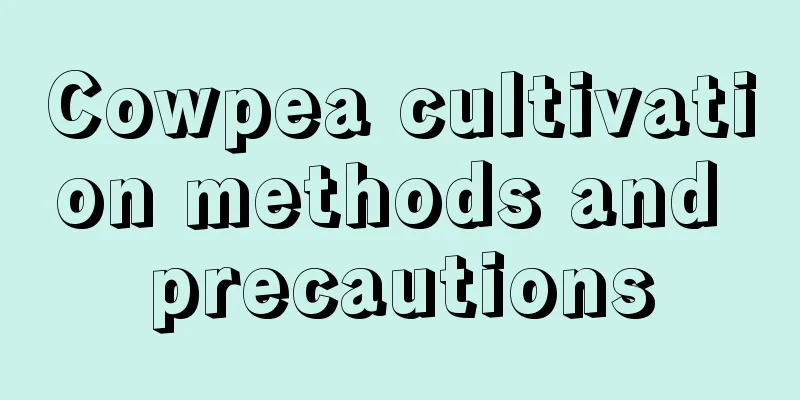Cowpea cultivation methods and precautions

1. Maintenance methods1. Soil: It needs a lot of nutrients to grow, so you must use relatively fertile soil. Its roots are not tolerant to waterlogging. In addition to being fertile, the air permeability of the soil must also be considered so that the accumulated water in the soil can be removed. 2. Watering: It needs to be watered sufficiently when everyone starts planting. The next time to water is after it blooms. If the flower is too dry during the growth period, it needs to be watered manually once a week. When watering, you must follow the principle of "watering the pods but not the flowers", because its flowers will fall off when they come into contact with water, which is not conducive to the growth of the plant. 3. Fertilization: In addition to the base fertilizer used in the soil before planting, it needs to be fertilized again every month. When it grows, it has relatively high requirements for phosphorus and potassium fertilizers. Therefore, when fertilizing, you should use fertilizers with relatively high phosphorus and potassium content. In addition to root fertilizers, you also need to use foliar fertilizers. This is because it will show symptoms of trace element deficiency in its subsequent growth, such as yellow leaves, etc. So in order to prevent this situation, you need to spray foliar fertilizers on it during the seedling stage. 4. Light: Although it is a short-day plant, many varieties are medium-light-tolerant, so the light requirements are not strict. 2. Breeding techniques1. Reproduction: It can be propagated by sowing. Its seeds are relatively large. Before sowing, they need to be soaked in cooled boiled water for 48 hours and then sown into the soil. After sowing, cover with soil and water sufficiently, and seedlings will emerge in about a week. 2. Pruning: Newly grown seedlings need to be topped off to promote the growth of side branches. 3. Problem Diagnosis1. Pests: It is easily infected by borers. Before pods form, you need to spray it with chlorothalonil as a preventive measure. If it is unfortunately still infected, you need to use insecticides to kill the insects. It should be noted that pesticides are toxic, and the pods cannot be picked for the time being after spraying. You must wait at least one to ten days before picking them. 2. Yellow leaves: Yellow leaves on the plant may be caused by insufficient nutrients. You need to increase the nutrition and fertilization frequency. IV. Other issues1. Edibility: It is edible. 2. Toxicity: Unfried pods are poisonous and can easily cause diarrhea. Therefore, when eating, it must be cooked thoroughly before eating. |
<<: Cultivation methods and precautions of rowan
>>: Cultivation methods and precautions of wolfsbane
Recommend
Are the fruits of ornamental plants edible?
Are the fruits of ornamental plants edible? 1. Le...
How often do you water the bird's nest fern?
1. Spring and Autumn Bird's nest fern likes m...
Cultivation methods and precautions of small green vegetables
1. Soil The root system of green cabbage is relat...
How to cultivate American pokeweed
1. Soil American pokeweed has low soil requiremen...
What to do if the soil of potted flowers becomes compacted
The reason why the soil of potted flowers is comp...
Clivia and green radish root rot, the method is very simple
Clivia root rot 1. Turn the Clivia upside down fr...
What is gourd?
What is gourd? The gourd is a plant of the genus ...
Which species of wild orchid is the most precious?
1. Which species is the most precious? Generally ...
Don't eat these poisonous flowers. Be careful if you have children or pets at home.
Euphorbia pilosa If you scratch or break the Euph...
This flower is beautiful and easy to grow. You must get a pot of it in spring, otherwise you will lose out!
How to grow Dendrobium officinale? Dendrobium off...
Why does Milan drop its leaves?
1. Insufficient light Milan is a strong sun-lovin...
How many kilograms of peanuts are produced per mu?
Peanut yield per mu The annual yield per mu of pe...
When is the best time to plant lupine seeds?
Lupine seed planting time Lupine is an annual her...
Lemon cutting method
Time for cuttings The most suitable time for cutt...
Can I plant pine trees at home?
Can I grow pine trees at home? Pine trees can be ...









